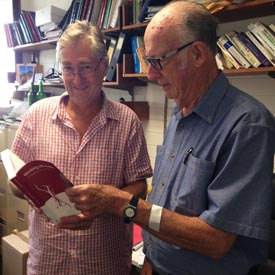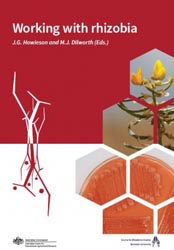Centre for Rhizobium Studies published manual "Working with Rhizobia".
The nitrogen-fixing symbiosis between legumes and soil bacteria (known as rhizobia) is fundamental to sustainable agriculture. While synthetic nitrogen fertilisers have boosted agricultural outputs, they require large amounts of fossil fuels, whose burning increases production of greenhouse gases. In contrast, rhizobia in legume nodules are able to fix atmospheric nitrogen and supply it to their legume partners, and so can provide food and fibre to a growing world population while maintaining soil fertility and the natural environment. This process is called symbiotic nitrogen fixation.
Now, Murdoch University’s Professor John Howieson and Emeritus Professor Mike Dilworth have edited the first legume-rhizobia techniques manual in over 30 years for all those working in the field of symbiotic nitrogen fixation. The idea for the book came about at a workshop held on Rottnest Island, off the coast of Perth, in 2011. At the workshop, which was sponsored by N2Africa, it was decided that an updated manual would be very timely, given the launch of N2Africa and the new focus on N-fixation. This manual brings together state-of-the-art methods for the study of root-nodule bacteria, both in the free-living state and in symbiosis with legumes.
 |
The editors admiring the new publication |
 |
In each chapter, the manual introduces a topic and provides guidance on how study of the symbiosis might best be tackled. Detailed descriptions are provided of the protocols that need to be followed; potential problems and pitfalls are identified. Topics covered include acquiring, recognising, growing and storing rhizobia, experimenting with strains in the laboratory, glasshouse and field, and applying contemporary molecular and genetic methodologies to assist in the study of rhizobia.
The manual "Working with rhizobia" is especially relevant for researchers in agricultural systems that are constrained by nitrogen infertility, but where farmers cannot afford the high cost of manufactured fertiliser.
Research support for this manual was provided by Murdoch University, ACIAR, the Crawford Fund and the Bill & Melinda Gates Foundation (through N2Africa), and Australian Wool Innovation and the Grains Research and Development Council (through the National Rhizobium Program).
Professor John Howieson, Murdoch Univeristy and former N2Africa Advisory Committee member.
*N2Africa is purchasing 100 copies for distribution to partners. Please write to N2Africa.office@wur.nl if you want one.
ESRC - DFID Project: Assessing the impact of agricultural extension and input subsidies in Eastern DRC
Researchers from the Development Economics Group at Wageningen University teamed up with the N2Africa program to assess the impact of their program in Eastern DRC. The key research objectives are to (1) create an assessment of household characteristics and needs for improving agricultural yields in Eastern DRC (2) Assess the impact of the N2Africa agricultural extension services and access to subsidized inputs on knowledge, attitudes and adoption of new inputs for grain legumes.
The research project is a joint effort between Wageningen University and the International Institute for Tropical Agriculture (IITA), International Center for Tropical Agriculture (CIAT), Consortium for Improving Agriculture-based Livelihoods in Central Africa (CIALCA), Catholic University of Bukavu, and UNU-MERIT as well as the DRC based implementing organisations PAD, DIOBASS, WOMEN for WOMEN, SARCAF, IPLCI & CDC/Kiringye. Funding is provided by the Growth Research Program of ESRC - DFID.
The first main descriptive and qualitative research findings are now online via www.n2africa.org, N2 Links and in near future more will be uploaded. Results of the impact assessment are available soon.
Contact: For more information please contact Maarten Voors via maarten.voors@wur.nl
